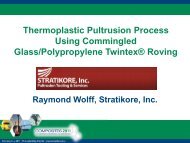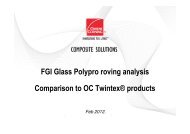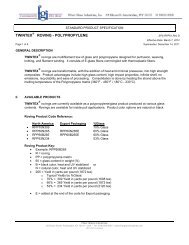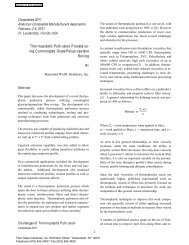Thermoplastic Pultrusion Process using commingled glass ...
Thermoplastic Pultrusion Process using commingled glass ...
Thermoplastic Pultrusion Process using commingled glass ...
Create successful ePaper yourself
Turn your PDF publications into a flip-book with our unique Google optimized e-Paper software.
Return to FGI website<br />
Composites 2011<br />
American Composites Manufacturers Association<br />
February 2-4, 2011<br />
Ft. Lauderdale, Florida USA<br />
Abstract<br />
Composites 2011<br />
<strong>Thermoplastic</strong> <strong>Pultrusion</strong> <strong>Process</strong> <strong>using</strong><br />
Commingled Glass/Polypropylene<br />
Roving<br />
By<br />
Raymond Wolff, Stratikore, Inc.<br />
This paper discusses the development of a novel thermoplastic<br />
pultrusion process utilizing <strong>commingled</strong><br />
<strong>glass</strong>/polypropylene fiber roving. The development of a<br />
commercially viable thermoplastic pultrusion process<br />
resulted in combining technologies, tooling and processing<br />
techniques from both pultrusion and extrusion<br />
manufacturing processes.<br />
First commercial applications included the development<br />
of unidirectional pultrusions for the fence and tool handle<br />
market. Additional development also produced<br />
transverse reinforced profiles, twisted profiles as well as<br />
unique capstock extrusion effects.<br />
The result is a thermoplastic pultrusion process which<br />
opens the door to future advances utilizing other thermoplastic<br />
resins, reinforcement fibers and direct thermoplastic<br />
resin injection. <strong>Thermoplastic</strong> pultrusion also offers<br />
the possibility for pultrusion and extrusion manufacturers<br />
to expand into new product and market segments<br />
not otherwise open and available to them currently.<br />
Challenges of <strong>Thermoplastic</strong> <strong>Pultrusion</strong><br />
1<br />
The notion of thermoplastic pultrusion is not novel, with<br />
first published work going back to 1985. (1)(2) However<br />
the ability to commercialize production of lower cost,<br />
high volume applications has faced several challenges<br />
and obstacles for the processor.<br />
In contrast to pultrusion resin formulation viscosities that<br />
typically range from 100 to 5,000 CPS, thermoplastic<br />
resins such as Polypropylene, PVC, Polyethylene and<br />
others exhibit relatively high melt viscosities of up to<br />
500,000 CPS in comparison.(2) In addition, thermoplastic<br />
resins only exhibit their reduced viscosities at elevated<br />
temperatures, presenting challenges to resin delivery<br />
and wetout <strong>using</strong> traditional pultrusion processing<br />
techniques.<br />
Increased viscosities have a direct effect <br />
ability to efficiently and properly achieve fiber wetout.<br />
(3) A general relationship for defining wetout was proposed<br />
in 1984 as follows:<br />
<br />
<br />
Where = resin temperature when applied to fiber,<br />
The process was capable of producing unidirectional and = work applied to fibers, = immersion time, and =<br />
transverse reinforced profiles ranging from small diame- resin viscosity. (3)<br />
ter rods up <br />
profiles.<br />
As seen in this general relationship, as resin viscosity<br />
Capstock extrusion capability was also added to allow increases, under the same conditions, the ability to<br />
great flexibility in easily adding beneficial attributes to properly wetout fibers decreases. Not only does viscosity<br />
the underlying composite profile.<br />
affect ability to maximize the resin & fiber<br />
interface, it is also an important variable on the permeability<br />
of the resin through a fiber matrix during<br />
wetout, profile forming and ultimate consolidation.<br />
Fiber Glass Industries, Inc. 69 Edson Street * Amsterdam, NY 12010<br />
Telephone (518) 842-4000 * Fax (518) 842-4408<br />
Since the melt viscosities of thermoplastics resins are<br />
significantly higher, published experimental work on<br />
thermoplastic wetout of fibers has primarily focused on<br />
the methods and techniques to maximize the work ()<br />
component of this general wetout relationship.<br />
<strong>Thermoplastic</strong> techniques to improve this work component<br />
() generally consist of either applying increased<br />
pressures or mechanical methods to increase fiber wetout<br />
by the thermoplastic resin.<br />
A number of published articles speak on the use of heated<br />
wetout pins to improve melt flow along fibers and re-
Return to FGI website<br />
duce void content of <strong>commingled</strong> glaaa/polypropylene<br />
fibers (4)(5)<br />
Another challenge is to also account for the differences<br />
in the elevated temperature behavior of a thermoplastic<br />
composite versus that of traditional thermoset pultrusions<br />
during processing. At elevated processing temperatures,<br />
thermoplastic composites are much more fluid in their<br />
behavior and the control of profile temperature during<br />
processing is more significant in forming a finished profile<br />
to exacting dimensions.<br />
An additional challenge in tooling and process design<br />
was to also account for the viscoelastic characteristics of<br />
thermoplastics resins to exhibit die swell and expansion<br />
during processing.(6)(8) Figure 1 depicting model of<br />
die swell behavior of tubular extruded profile.<br />
Utilizing a Commingled Roving<br />
The initial use and selection a <strong>commingled</strong><br />
<strong>glass</strong>/polypropylene (Glass/PP) fiber roving was chosen<br />
primarily to reduce overall development time and seen as<br />
a first step towards future developments of direct thermoplastic<br />
resin injection.<br />
The Twintex®, Glass PolyPro Roving is a roving product<br />
that is a <strong>commingled</strong> yarn of <strong>glass</strong> fibers combined<br />
with polypropylene fibers. Production of a <strong>commingled</strong><br />
fiber product involves the addition of a multi-filament<br />
extrusion process to the <strong>glass</strong> manufacturing process.<br />
See Figure 3 depicting the manufacturing process used to<br />
make <strong>commingled</strong> <strong>glass</strong>/polypropylene roving. This extrusion<br />
process is commonly used in the production of<br />
carpet yarns.<br />
The use of Twintex, Glass PolyPro Roving was chosen<br />
for several reasons:<br />
Commingled <strong>glass</strong> allowed thermoplastic resin<br />
to be predistributed throughout the fiber matrix.<br />
Set <strong>glass</strong> fiber concentrations of 60% and 75%<br />
(by wt.)<br />
Polypropylene resin of mid range melt flow index<br />
(MFI)<br />
Reduced preliminary cost and development time<br />
of adding additional in-situ extrusion resin deliver<br />
equipment to processing line.<br />
Provided in a roving package that product manufacturing<br />
staff was experienced in handling.<br />
Composites 2011<br />
Fiber Glass Industries, Inc. 69 Edson Street * Amsterdam, NY 12010<br />
Telephone (518) 842-4000 * Fax (518) 842-4408<br />
2<br />
Ability to easily and accurately adjust range of<br />
fiber content by altering ratio of 60% and 75%<br />
rovings used in profile.<br />
Available in high quantities.<br />
Proven product history and processing<br />
knowledge from other composite processes utilizing<br />
product.<br />
These benefits did, however; come at a premium to the<br />
final product cost. Raw material cost analysis of <strong>glass</strong><br />
fiber and polypropylene does demonstrate that <strong>commingled</strong><br />
fiber comes at a significant cost premium to the<br />
processor. Significant cost saving opportunities are<br />
shown to exist with future process advancements utilizing<br />
direct extrusion resin impregnation techniques.<br />
Driven by Heat, not by Reaction Limitations<br />
Unlike traditional thermoset pultrusion, in which speeds<br />
are typically driven by the limits of resin polymerization<br />
kinetics, the thermoplastic pultrusion process is not limited<br />
on such factors. [7]<br />
Three dominant factors influencing product speeds and<br />
quality are heat energy input, tooling design and part<br />
cooling consolidation.<br />
As with thermoplastic extrusion, line speed is directly<br />
related to the process to <br />
quickly and efficiently<br />
heat up the thermoplastic resin to melt temperature,<br />
have sufficient work be applied to create adequate<br />
wetout and to efficiently remove heat while consolidating<br />
and setting the part to final part dimensions.<br />
Utilizing both <strong>Pultrusion</strong> and Extrusion Techniques<br />
to Build a Line<br />
Unlike thermoset pultrusion lines which use typical die<br />
- , tooling was altered to take into account<br />
the processing characteristics of thermoplastics.<br />
<strong>Process</strong>ing <strong>commingled</strong> <strong>glass</strong>/polypropylene fibers<br />
through traditional tooling setups, fails to account for the<br />
differences of pultruding two vastly different resin families.<br />
For a thermoset pultruder to process most thermoplastic<br />
resins in the same manner as thermoset resins<br />
would most likely not lend itself to the to a process of<br />
commercial viability for most thermoplastics.
Return to FGI website<br />
To account for the material differences, principles from<br />
extrusion tooling, die and calibration equipment were<br />
adapted and utilized to accommodate the thermoplastic<br />
pultrusion process. Borrowed extrusion technologies incorporated<br />
the adoption of chilled water calibration systems<br />
and segmented tooling.<br />
Calibration techniques and tooling are well established<br />
processing steps for the extrusion process. Calibration of<br />
profiles allows for removal of heat in a controlled fashion<br />
while tooling assists to properly size and calibrate the<br />
finished product during processing. See Figure 1A<br />
showing a view of a typical calibration system used in<br />
the manufacturing of extruded PVC window profiles.<br />
See Figures 4, 4A and 4B depicting several configurations<br />
of calibration techniques used in extrusion processing.<br />
The <strong>Thermoplastic</strong> <strong>Pultrusion</strong> <strong>Process</strong><br />
The thermoplastic pultrusion process developed utilizing<br />
the <strong>commingled</strong> <strong>glass</strong>/polypropylene roving consists of<br />
the following sections:<br />
Fiber/reinforcement storage area<br />
Fiber Preheating*<br />
<strong>Thermoplastic</strong> Melt and Fiber Wetout<br />
Profile Forming & Consolidation<br />
Composite Calibration Tooling<br />
Capstock Extrusion*<br />
Capstock Embossing/Knurling*<br />
Final Cooling and Calibration<br />
Cutoff Saw<br />
*denotes optional sections depending on finished part<br />
requirements<br />
Line Diagram - See Figure 2 depicting line layout of the<br />
developed thermoplastic pultrusion line.<br />
Initial Commercial Applications<br />
Composites 2011<br />
3<br />
isting wrought iron and aluminum ornamental fencing<br />
products in the commercial segment.<br />
Extrusion capstocking allowed a high aesthetic surface to<br />
be applied to the underlying composite profile. Also the<br />
capstock was a highly UV resistant resin capable of<br />
meeting the extreme weathering demands of fencing<br />
products. Using a compatible capstock can also take advantage<br />
of residual profile heat to promote adhesion between<br />
the composite and capstock layer.<br />
The added capstocking capability can relieve the demands<br />
on processors in adding resin additives to the<br />
composite matrix for certain characteristics such as UV<br />
resistance, surface finish or color.<br />
The second commercial application consisted of innovative<br />
tool handle designs that took advantage of the lines<br />
capstocking capabilities. See Figures 6, 7, 8, 9 showing<br />
capstocking and special effect that can be applied to the<br />
capstock layer.<br />
Capstocking also allowed resins of two different types,<br />
colors and/or durometers to be applied longitudinally<br />
during processing, adding new design options for tool<br />
handle manufacturers. See Figure 7 depicting capstocking<br />
of profile with two differing colors and durometer<br />
materials.<br />
Profiles incorporating transverse fiber reinforcement was<br />
also performed utilizing existing <strong>glass</strong>/polypropylene<br />
woven sheet material. See figure 10 showing channel<br />
profile produced <strong>using</strong> transverse woven<br />
<strong>glass</strong>/polypropylene sheet material on outer layers.<br />
Why <strong>Thermoplastic</strong> <strong>Pultrusion</strong>?<br />
Earlier papers regarding benefits that thermoplastics pultrusions<br />
offer are discussed as offering the following<br />
benefits (7):<br />
Increased impact resistance<br />
First commercial product applications consisted of prod-<br />
Increased toughness<br />
ucts for the ornamental fencing market and existing tool<br />
Thermal and ultrasonic part welding See Fig-<br />
handle market.<br />
ures 11, 12 showing thermal welding used to<br />
join two fence tube profiles and cutaway of ul-<br />
Five ornamental fence profiles were produced that<br />
trasonically welded ID plug in round tool han-<br />
<br />
profile, up <br />
dle profile.<br />
x See Figure 5 showing <br />
product fence profiles. This product line was designed<br />
as a composite fence product that competed against ex-<br />
Fiber Glass Industries, Inc. 69 Edson Street * Amsterdam, NY 12010<br />
Telephone (518) 842-4000 * Fax (518) 842-4408
Return to FGI website<br />
Limited post forming capabilities Figure 13<br />
showing limited circular twisting of fence tube<br />
profiles.<br />
High line speeds<br />
Minimal to no volatile emissions during processing<br />
Better recyclability opportunities<br />
New design and market opportunities<br />
Potential cost savings<br />
Selective extrusion profile reinforcement offers<br />
new product opportunities. Figures 14, 15 depicting<br />
concept of selective reinforcement of extruded<br />
profiles <strong>using</strong> small diameter thermoplastic<br />
pultruded rods.<br />
New Market Opportunities<br />
The development of a thermoplastic pultrusion process<br />
opens up new possibilities for product design. From a<br />
completely reinforced profile down to an extruded profile<br />
reinforced with strategically placed fibers, a new<br />
broad spectrum of physical performance is opened up for<br />
product designers.<br />
Strategic reinforcement<br />
Selectively reinforcing PVC fence, window and decking<br />
profiles offer the opportunity to significantly improve<br />
flexural modulus of existing profiles. This affords extruders<br />
opportunities to reduce or eliminate aluminum<br />
stiffeners and to increase part spans. A broader range of<br />
material properties can be offered to final customers and<br />
product designers. See Figures 14, 15 depicting concept<br />
of selective reinforcement of extruded profiles <strong>using</strong><br />
small diameter thermoplastic pultruded rods.<br />
Reduced fabrication costs<br />
Corner welding can reduce or eliminate gusset costs.<br />
Welding offers opportunity to join parts and/or eliminate<br />
adhesive operations. See Figures 11, 12 showing thermal<br />
welding used to join two fence tube profiles and cutaway<br />
of ultrasonically welded ID plug in round tool handle<br />
profile.<br />
New Design Options<br />
Profile twisting, capstock features and added extrusion<br />
capabilities bring new level of features and improved<br />
cosmetics for designers to incorporate. Figure 13<br />
Composites 2011<br />
Fiber Glass Industries, Inc. 69 Edson Street * Amsterdam, NY 12010<br />
Telephone (518) 842-4000 * Fax (518) 842-4408<br />
4<br />
Future Development Opportunities<br />
Future developments involve improvements in wetout<br />
and part consolidation to optimize composite mechanical<br />
properties.<br />
Initial line developments yielded the underlying composite<br />
reaching 80-85% of theoretical strengths. These<br />
lower than expected values were mainly attributed to<br />
first generation calibration tooling system that was utilized.<br />
Refinement in calibration tooling and cooling offer opportunities<br />
to achieve higher line speeds, improve product<br />
quality, narrow part tolerances and achieve higher<br />
theoretical strength values.<br />
The addition of a future in-situ resin extrusion injection<br />
system also creates an alternative to <strong>using</strong> <strong>commingled</strong><br />
fiber rovings and open opportunities for cost reduction<br />
and additional thermoplastic resin options.<br />
Conclusion:<br />
A commercially viable thermoplastic pultrusion process<br />
has been developed <strong>using</strong> <strong>commingled</strong><br />
<strong>glass</strong>/polypropylene roving that offers many new product<br />
opportunities.<br />
The process utilized processing and tooling techniques<br />
from both standard extrusion and pultrusion processes.<br />
The created thermoplastic pultrusion line was a hybrid of<br />
these technologies capable of adequately wetting out<br />
<strong>glass</strong> fibers while also accommodating the nature of the<br />
thermoplastic resin in the final profile formation.<br />
Such a process opens up new possibilities in new products<br />
based on families of thermoplastic resins being<br />
manufactured into pultruded composites.<br />
These new possibilities are not only limited to existing<br />
pultrusion markets and application but can also serve the<br />
opportunity to expand traditional extrusion markets by<br />
increasing performance with the addition of continuous<br />
fibers reinforcements.
Return to FGI website<br />
Acknowledgments:<br />
Jim Shobert, Chairman, Polygon Company, Walkerton,<br />
IN<br />
Ben Shobert, Indiana University Research Center for<br />
Chinese Politics and Business, Indianapolis, IN<br />
John Menzel, Chairman, Fiber Glass Industries, Amsterdam,<br />
NY<br />
TWINTEX® is a registered trademark of Owens Corning<br />
Authors:<br />
Ray Wolff, President, Stratikore, Inc & HotSnapZ.com<br />
Email: rwolff@stratikore.com<br />
B.S. Engineering, Macromolecular Science Engineering<br />
Case Western Reserve University, Cleveland, OH<br />
Over 20 years experience in pultrusion manufacturing,<br />
tooling design, training and market development.<br />
References:<br />
1. Experimental investigation of pultrusion of <strong>glass</strong> fibre<br />
reinforced polyropylene composites., A. Carlsson and T<br />
Astrom, Composites Part A 29A, pg 585-593, Elsevier<br />
Science Limited, (1998)<br />
2. Madenjian, A.R., Tessier, N.J. and Schott, N.R. Effects<br />
of significant processing variables on thermoplastic<br />
matrix pultruded composites, SPI Composites Institute<br />
Annual Conference, 40, 11F, (1985)<br />
3. <strong>Pultrusion</strong> <strong>Process</strong> Variables and Their Effect Upon<br />
Manufacturing Capability, J.E. Sumerak, J.D. Martin,<br />
39th Annual Conference, The Society of the Plastics Industry,<br />
(1984)<br />
4. High speed pultrusion of thermoplastic matrix composites,<br />
A.H. Miller, N. Dodds, J.M. Hale and A.G. Gibson,<br />
Composites Part A 29A, pg 773-782, Elsevier Science<br />
Limited, (1998)<br />
5. Technology for rapid impregnation of fibre bundles<br />
with a molten thermoplastic polymer., R. Marissen, L.<br />
Th. van der Drift, J. Sterk, Composites Science and<br />
Technology 60, 2029-2034, (2000)<br />
Composites 2011<br />
Fiber Glass Industries, Inc. 69 Edson Street * Amsterdam, NY 12010<br />
Telephone (518) 842-4000 * Fax (518) 842-4408<br />
5<br />
6. Fundamentals of Polymer <strong>Process</strong>ing, Stanley Middleman,<br />
McGraw-Hill Book Company, 1977 Plastics Extrusion<br />
Technology, ed. by Friedhelm Hensen, 2nd Edition,<br />
Handser-Gardner Publishers, Inc. pgs 64-71, 89-94,<br />
473 (1997)<br />
7. <strong>Pultrusion</strong>: An Expanding Technology, Opportunities<br />
for Innovation: Polymer Composites, NIST GCR 90-<br />
577-1, edited by Stuart Munson-McGee, (Aug. 1990)<br />
8. Plastics Extrusion Technology, ed. by Friedhelm Hensen,<br />
2nd Edition, Handser-Gardner Publishers, Inc. pgs<br />
64-71, 83, 89-94 (1997)
Return to FGI website<br />
Composites 2011<br />
Fiber Glass Industries, Inc. 69 Edson Street * Amsterdam, NY 12010<br />
Telephone (518) 842-4000 * Fax (518) 842-4408<br />
6<br />
Figure 1: Die Swell behavior of extruded tubular<br />
profile. (6) p. 473<br />
Figure 3: Commingled <strong>glass</strong>/polypropylene fiber<br />
manufacturing process.
Return to FGI website<br />
Figure 4 Twin orifice die and vacuum block calibrator<br />
used in window profile extrusion (8) p 89<br />
Figure 4A Extrusion segmented or template calibration<br />
(8) p. 91<br />
Composites 2011<br />
Fiber Glass Industries, Inc. 69 Edson Street * Amsterdam, NY 12010<br />
Telephone (518) 842-4000 * Fax (518) 842-4408<br />
7<br />
Figure 4B Vacuum tank with short vacuum calibration<br />
unit for profile and pipe production (8) p. 94<br />
Machine Design<br />
http://machinedesign.com/article/long-<strong>glass</strong>fiber-pp-hits-the-road-1024<br />
Accessed Sept 25, 2010<br />
Figure 5: <strong>Thermoplastic</strong> <strong>Pultrusion</strong> Fence System
Return to FGI website<br />
Figure 6: <strong>Thermoplastic</strong> <strong>Pultrusion</strong> Tool Handles<br />
Figure 7: <strong>Thermoplastic</strong> <strong>Pultrusion</strong> Tool Handles<br />
Inline Capstocking Detail<br />
Figure 8: <strong>Thermoplastic</strong> <strong>Pultrusion</strong> Tool Handles<br />
Inline Capstock K nurling<br />
Composites 2011<br />
Fiber Glass Industries, Inc. 69 Edson Street * Amsterdam, NY 12010<br />
Telephone (518) 842-4000 * Fax (518) 842-4408<br />
8<br />
Figure 9: Dual Capstocking of <strong>Thermoplastic</strong><br />
<strong>Pultrusion</strong> (Courtesy Polygon Company)<br />
Figure 10: T ransverse Fiber <strong>Thermoplastic</strong> <strong>Pultrusion</strong><br />
Channel profile no capstock<br />
Figure 11: Thermal Part Welding of <strong>Thermoplastic</strong><br />
<strong>Pultrusion</strong><br />
Figure 12: Spin Welding of End Plug into <strong>Thermoplastic</strong><br />
<strong>Pultrusion</strong> Tool Handle
Return to FGI website<br />
Figure 13: Post Forming of <strong>Thermoplastic</strong> <strong>Pultrusion</strong><br />
- Twisting<br />
Figure 14: Selective Reinforcement of recycled<br />
deck profile <strong>using</strong> <strong>Thermoplastic</strong> <strong>Pultrusion</strong>s<br />
Figure 15: Selective Reinforcement Concept (5)<br />
Composites 2011<br />
Fiber Glass Industries, Inc. 69 Edson Street * Amsterdam, NY 12010<br />
Telephone (518) 842-4000 * Fax (518) 842-4408<br />
9<br />
Figure 16: Capstock Embossing Equipment







